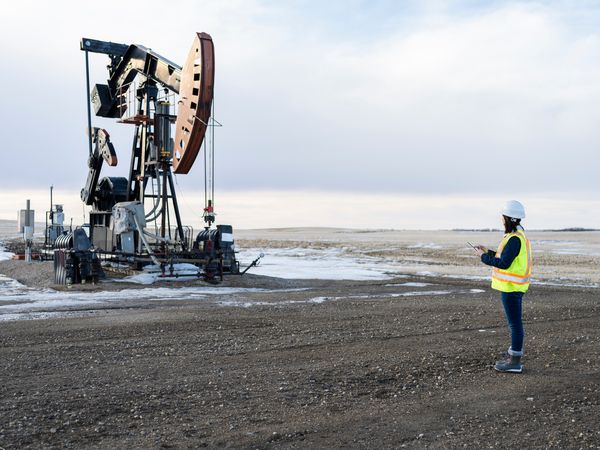Just recently, oilfield services companies reported their Q2 earnings. They were bad, but Q3 is forecasted to be even worse.
The lifeblood of oilfield services companies is drilling and completing wells. After discovery, drilling is the next step in hydrocarbon extraction. It's little more than drilling a hole vertically, and then usually horizontally, to get to the reserves. Oilfield services companies make money by leasing rigs and contracting their crews to companies like ExxonMobil or Chevron, known as the operators of the well.
Drilling declines
The best way to keep tabs on the health of drilling activities is the Baker Hughes rig count. Released weekly and free to access, the rig count provides a good reading on drilling activity, allowing investors to gauge if new wells are being brought online.
The rig count has been declining for months now as drilling activities are heavily stalling in the face of $55 a barrel oil and a lack of pipelines available to transport reserves out of plays like the Permian Basin in West Texas, the largest oilfield in the United States.
Frac Job Declines
Frac jobs have been declining as well. Frac jobs involve completing the well by injecting large amounts of water, sand, and other fluids that cause fissures in the hard shale rock, freeing up hydrocarbons to permeate through the rock and flow back up to the surface.
Contrary to popular belief, fracing can take just two or three days and don't have to be done at the same time as drilling. In fact, the number of drilled but uncompleted, known as DUCs, has been rising for months as well. Rising DUC numbers is also a bad sign for oil services companies, who are paid to complete wells as the final step before production.

Image Source: Getty Images.
Rig counts differ by well depth
Conventional wells don't require fracing whereas unconventional wells, common onshore in places like the Permian, require hydraulic fracturing to increase pressure and bring the hydrocarbons to the surface. Offshore wells are typically deeper but onshore wells are diving deeper and deeper as well in order to access untapped reserves.
According to an analysis by Spears & Associates, while offshore and conventional wells had a steady rig count, unconventional wells differed substantially based on different 5,000-foot increments. For example, the < 10,000-foot shallow wells decreased sharply but the 10,000-15,000-foot range showed signs of increase. It seems that operators prefer bigger, more predictable projects at greater depths and longer laterals for onshore and conventional wells with long project durations offshore.
The greater than 15,000-foot onshore depth category is up 9% since the end of 2018 and has been steady since May despite declining overall rig count. This > 15,000-foot category now makes up 20% of active rigs today.
Less dominant onshore supermajors like Royal Dutch Shell (NYSE: RDS-A) (NYSE: RDS-B) are choosing to drill >15,000 depths when they decide to dip their toes into a new play. These bigger projects provide improved cost structure and a reasonable pitch to investors who prefer certainty and predictability.
Traditionally, the majority of service company earnings have come from international investments. During the >$100 barrel years, that shifted onshore. The service companies overplayed their hand, now they are spread thin and are reverting back to their tried and true international business models.
What this means for the oilfield services companies
It's well known that the oilfield services companies, most notably Schlumberger (SLB 0.60%), Halliburton (HAL 0.50%), and National Oilwell Varco (NOV 0.83%), have been struggling since the 2014 oil downturn. Many smaller oilfield services companies have gone flat out bankrupt. Weatherford, not small by any means, became overwhelmed by over $8 billion in debt. Consequently, the company was forced to file for Chapter 11 bankruptcy in late June.
According to a recent Bloomberg story: "In June 2014, the U.S. pumped 8.4 million barrels of crude using 1,545 drilling rigs. Last month, it produced about 12.2 million barrels, 45% more, with just 788 rigs."
For the rest of the industry, this is wonderful news, but for oilfield services companies large and small, these efficiencies have caused severe overcapacity and economic pain. The advent of data-driven drilling and production reduces costs for operators by integrating machinery into a system of systems. Drilling multiple wells from one rig, and the surge in padded wells increase the output of each rig, leading to greater profitability for operators but less business for oilfield services companies.
Oil majors are becoming more and more cost-conscious, focused intently on reducing breakeven prices per barrel to sustain profitably during downturns. Meanwhile, the oilfield services companies have seen quarter after quarter declines with no floor insight to bounce back from. Until that floor is found, it may be prudent to conclude that there is little hope in sight for oilfield services companies.








